
Artist Lynn VanderHerberg (right) and Dorothy Fletcher are seen here inside the historic hops barn at its new Codrington home. /Sarah Hyatt/MBC
Brighton’s historic hops kiln barn built in 1880 has been saved from destruction and will have a new chapter in Codrington.
Believed to be one of the last physical reminders of what was a bustling hops industry, the relocation of the 144-year-old barn to the Codrington Community Centre property has been years in the making, originally started by the late Dennis ‘Fletch’ Fletcher.
That was Bruce Davis, secretary-treasurer of the Brian Todd Memorial Community Fund (BTMCF), which took over shepherding the project to completion after Fletch passed.
To relocate the barn from the old Memory Junction Museum property, it took dozens of partners and volunteers – in-kind donations, area businesses, suppliers, tradespeople and more – offering their time, expertise, materials and labour, free of charge.
Their job was not easy. They had to carefully dismantle and relocate the barn and then reassemble and revitalize it for its next life. And while it was an immense undertaking, it turned out to be a beautiful and inspiring journey, encapsulating the spirit of this community.
“Through your generous actions, you have not only preserved these bones, but perhaps more importantly, you have preserved the history that they represent,” Davis told supporters crowded into the barn at its new location for a “big reveal” on a brisk Friday morning.
The gathering was emotional, and its purpose was simple.
The Nov. 22 gathering was an appreciation event – a chance to honour all the builders and people who helped ensure this piece of Brighton’s agricultural history will continue to stand for years to come.

As Davis gathered supporters, he recalled the journey to get to this point, and how the barn was originally housed near Telephone Road and Spring Valley Road before the move to Memory Junction in 2002.
As attendees walked into the barn, two restored plaques on the right of the doors welcomed them with dedications recognizing Willet Bedal and Elijah McMaster, the two 23-year-old men who originally built the barn.
A plaque on the left was added to recognize the people who saved the barn, including Basil McMaster and Ralph and Eugenia Bangay, who ensured the historic structure survived its first relocation from east of Smithfield to Memory Junction. McMaster, who initiated the first move, was 85 years old in 2002.
The same plaque honours Fletch, who after the loss of Memory Junction, set this latest relocation in motion before his passing in his 78th year. He was devoted to this project, Dorothy Fletcher, his wife of 37 years, recalled at the gathering, while delving into the origin story of how the barn landed in Codrington – and almost didn’t.
“My late husband Fletch … was aware of this barn because of his friendship with Basil McMaster,” shared Dorothy.
It was 2019 when Fletch hatched a plan to move the barn from Memory Junction to where it stands today, said Dorothy, adding his great ally was engineer Tim Krahn, who was equally passionate about the project.
“Unfortunately, soon after came the pandemic, and unfortunately, in September 2023, Fletch passed away, and it seemed at that point that the project was not going to happen.”
That was until Davis came along saying the Brian Todd Memorial Community Fund could help.
Dorothy shared how she’s been watching the barn come to life at its new home and delivered a heartfelt thank you to supporters on behalf of the Fletcher family for seeing her late husband’s vision through.
Back in the day, the barn was significant to the community, explained Davis.
The dried hops were mostly shipped to the Genesee Brewing Company in Rochester, N.Y., until the imposing of tariffs in the U.S. crippled the local industry to the point where it disappeared by 1915, said Davis.
As years went on, there was a transition to a general use barn – until its move to Memory Junction, where Ralph happily used it as an extension to his museum for 15 years.
“Who knows what would have happened to the barn if Ralph had not agreed to accept it (from Basil),” noted Davis.
Of course, not all the original barn now remains – a lot of the original posts and beams didn’t survive the first dismantling.
A “drying rack” on the higher level is no more. At one point, there would’ve been hops cones spread over cheesecloth or other fabric and heated from a woodstove below it. An upper floor no longer exists, where it’s believed the dried hops cones were bagged.
“But the important pieces – the 145-year-old posts, beams and trusses – those important structural bones remain intact,” said Davis.
Why is this important?
And there were a multitude of individuals who stepped up to save those bones and the story of this barn, each of whom were publicly recognized and gifted commemorative plaques/paintings of the barn at the gathering.
The presentations were kicked off with a breathtaking unveiling of a painting of the barn at its former Memory Junction location by Lynn VanderHerberg, which was later gifted to the children of Ralph and Eugenia and their spouses, stirring a heartwarming moment.

“That one-of-a-kind painting needs a home, and we cannot think of a better home than within the Bangay family,” remarked Davis.
Among the many to thank included Cole’s Timber Mart. Cole’s George and Mitch Hamilton donated the barn. (Cole’s eventually expanded into the property where the museum used to be and acquired the barn.)

A dedicated team of six from Cole’s Installations tackled most of the teardown at Memory Junction.
Municipal and county support was also needed, as the organization eyed public property as the best and only option to ensure the barn remains insulated from future private-sector transactions, explained Davis.
Council and staff support related to permits and site-plan approvals, et cetera, was crucial in advancing the project, said Davis. Meanwhile, technical drawings were needed to obtain those permits – that’s where Krahn and architect Reno Piccini stepped in.
To put the barn on solid ground, the group rallied the services of three other companies: QBT Excavating and Services Ltd., Crete Works Concrete Finishing LTD., and Quinte Mobile Concrete Service, said Davis, before recognizing a dozen individuals for their contributions to the project between these companies.
Another three people stepped up through Loyalist Timber Framing to handle reconstruction efforts relating to the original posts and beams, and more.
Vanderlaan Building Products Ltd. and owner Gerald Draaistra chipped in with donated time and materials and guidance throughout the project, added Davis.
A team of five at Vanderbros Construction was tasked with putting “the skin on the bones” – the new steel roof, installation of windows and doors, additional structural bracing, and reinstalling the siding.
The list of supporters also includes: VanVark Electric, Joe and Leigh Firlotte with Uncle Joe’s Attic (for restoration of plaques and gifting Basil’s book to Davis, setting him on this journey;) Justin Bryant (for transporting materials to Codrington), the Codrington Community Association, Ralph de Jong, Catherine Stutt, and Riley Richardson and Rob McDonald, who were working on finishing touches right up until the day before the event.

The final presentation at the gathering was the hardest to make because it was being made posthumously, shared Davis.
Visibly emotional and with his voice cracking at times, Davis recalled Fletch’s passion for the project before honouring Dorothy with a commemorative plaque.
For Davis, he remembers vividly the day (July 9) that the project started for him and emailing Fletch asking about whether he was interested in starting up again with the Brian Todd Memorial Community Fund taking a leadership role.
“Fletch emailed me back and while he supported the idea, (said) his health would not enable him to take part. I emailed him back and told him that I would keep him posted. He emailed me back and said, ‘please do.’”
After the gathering, Davis vowed to send out a special type of message to Fletch.
“After this event, I am going to send a message from all of us on angel’s wings and simply say: “We did it, Fletch. We did it.”
The revitalization of the barn is nearly complete, minus a few finishing touches like a spring paint job still to come. It’s anticipated doors will open to the public in spring.
As previously reported, upon completion, the group has said it will give the barn to the municipality.
Future uses are still to be determined, but ideas tossed around include complementing farmer’s market activities, space for education, recreation, commerce, the arts, history exhibits, and more.
(Written by: Sarah Hyatt)
